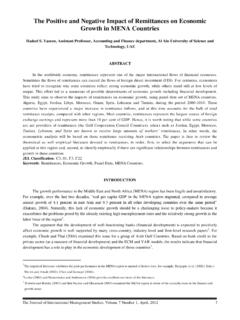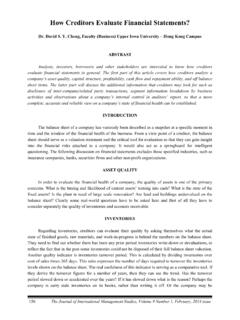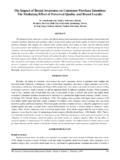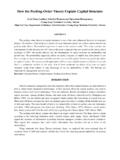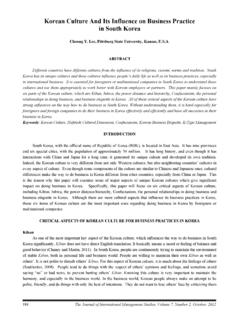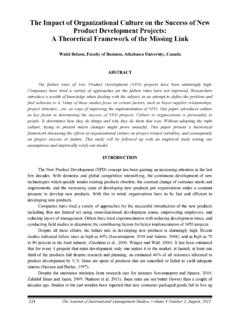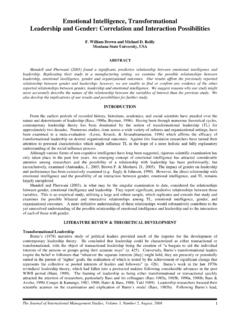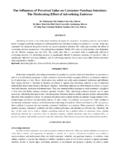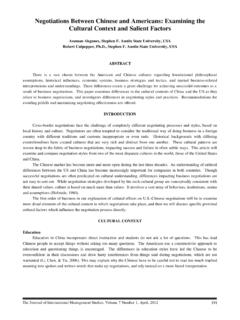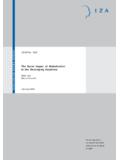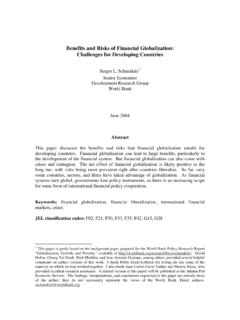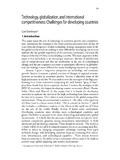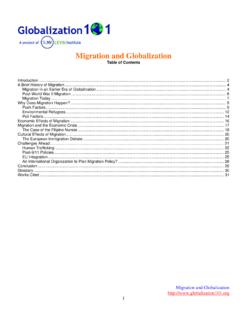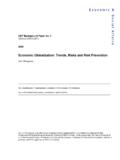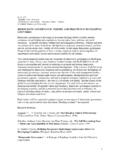Transcription of Impact of Globalization on Human Resource …
1 Impact of Globalization on Human Resource Management Bhushan Kapoor, Professor and Chair, Information Systems & Decision Sciences, Cal State University, Fullerton, USA ABSTRACT The roles and responsibilities of Human Resources departments are transforming as the modern business faces pressures of Globalization . The global supply of talent is short of its long-term demand, and the gap is a challenge for employers everywhere. The shortage between the demand and supply of talent is likely to continue to increase, notably for high skilled workers and for the next generation of business executives. Now organizations need to place greater emphasis on attracting Human capital rather than financial capital.
2 Global staffing and management of a workforce diverse in culture and language skills, and dispersed in different nations are the key goals of global Human resources. Only those multinational enterprises willing to adapt their Human Resource practices to the changing global labor market conditions will be able to attract and retain high performing employees. Companies with the ability to foresee their business needs and their workforce needs especially for high skills will gain the decisive competitive advantage. Keywords: Human Resource Management, Globalization , Data Analytics, Data Warehouse, Online Analytical Processing, Data Mining, Key Performance Indicators, Dashboards, Scorecards.
3 INTRODUCTION Human Resources departments are transforming as the modern business faces numerous and complex challenges, and exploit opportunities. The transformation of Human resources today is a direct call of the rapid changes within businesses due to factors such as Globalization . In the global competition within the flat and connected new world, decision making in organizations has become increasingly intricate and convoluted. The new global world has widened the talent pool for excellent and marginal workers, and for permanent and fluid workers. An organization s talent can be a source for a sustained competitive advantage and can affect important organizational outcomes such as survival, profitability, customer satisfaction level, and employee performance (Pfeffer, 1994; Prahalad, 1983).
4 Human resources need to take advantage of technology and data analytics to build a global Human Resource information system that collects and stores data from various sources. The system will help to analyze the data to provide business insights, predict future needs and develop strategies to fill those needs. Companies with the ability to foresee and sustainably manage their workforce needs especially for high skills will gain the decisive competitive advantage (World Economic Forum, 2010a). The global supply of talent is short of its long-term demand, and the gap is a challenge for employers everywhere.
5 The shortage between the demand and supply of talent is likely to continue to increase, notably for highly-skilled workers and for the next generation of middle and senior leaders. Most emerging nations with large populations, including Brazil, Russia, India, and China, may not be able to sustain a net surplus workforce with the right skills for much longer. Now, more than ever, organizations need to place greater emphasis on attracting Human capital rather than financial capital. Because capital is broadly available from investors and lenders, and innovations can be duplicated relatively easily and quickly, effective Human Resource management is the best way to differentiate one company from another.
6 Global staffing and global leadership development are the two components of global Human resources with the greatest potential for powerful leverage for global firms (Pucik, 1996). Only the multinationals that will be willing to adapt their Human Resource practices to the changing global labor market conditions will be able to attract, develop and retain the right talent, and will likely succeed in the global competition. The remainder of this paper is organized as follows: In section 2 we describe drivers of globalizations, and in section 3 we discuss some key challenges to Globalization . We discuss the changing roles and responsibilities of Human resources due to Globalization in section 4.
7 In section 5 we discuss global Human Resource information system and its major components. We summarize and conclude the paper in section 6. FACTORS DRIVING Globalization The increasing prevalence of Globalization is driven by a number of factors, including shortage of talent in developed countries, availability of low cost labor and growing consumers in developing countries, and technological progress. Shortage of Talent in Developed Countries Despite the current economic downturn and unemployment, most developed countries, including the United States, Germany and Japan will face long term talent shortages mainly due to ageing and the retirement of baby boomers.
8 There are more workers retiring than entering the labor force in these countries. By 2020, for every five retiring workers, only four new workers will join the labor force in most developed countries. According to one estimate the United States will need to add 26 million workers to its talent pool by 2030 to sustain the average economic growth of the two past decades (1988-2008) unless a technological breakthrough replaces manpower, while Western Europe will need to add 46 million employees (World Economic Forum, 2010). The shortage of workers is predicted across most industries, including manufacturing, construction, transport and communications, trade, hotel and restaurants, financial services, IT and business services, health care, public administration, and education.
9 Availability of Low Cost Labor from Emerging Countries The opportunity has never been greater for multinationals to attract top talent from emerging countries, such as Brazil, Russia, India, and China, or to outsource work to these countries. Global population growth differs greatly between developed and developing countries. In the developed countries, USA, EU, and Japan, the current annual rate of growth is less than per cent, while in the rest of the world the population is increasing almost six times as fast. According to McKinsey Global Institute, there are approximately 33 million potential professionals in emerging markets and they are growing very quickly.
10 The stock of suitable, young professional talent in emerging markets is growing at per cent annually, while the number in developed countries is growing at just 1 per cent annually (McKinsey Global Institute, 2005 - II). The total number of university-educated workers in low-wage countries far exceeds the number for higher wage countries. Currently, India produces as many young engineers as the United States, and China produces more than twice as many. Russia produces 10 times as many finance and accounting professionals as Germany. According to the International Organization for Migration, there were an estimated 214 million international migrants in the world in 2010, and fifty-seven per cent of all migrants live in high-income countries (World Migration Report, 2010).
